Previewing Maxiotek's MK8115 SSD Controller: Can DRAM-less Drives Make The Cut?
by Billy Tallis on May 9, 2017 8:00 AM ESTMixed Random Read/Write Performance
The mixed random I/O benchmark starts with a pure read test and gradually increases the proportion of writes, finishing with pure writes. The queue depth is 3 for the entire test and each subtest lasts for 3 minutes, for a total test duration of 18 minutes. As with the pure random write test, this test is restricted to a 16GB span of the drive, which is empty save for the 16GB test file.
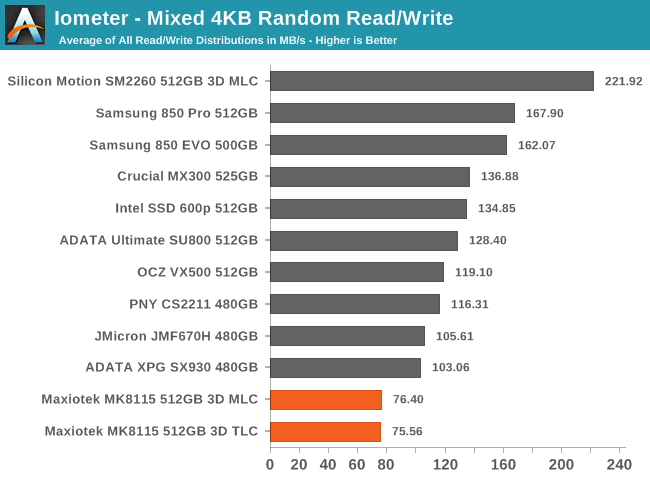
The MK8115 struggled with both random reads and random writes, so it's no surprise to see them turn in the lowest performance scores for the mixed random workload test. The MLC drive is only ahead of the TLC drive by a hair, and the next slowest drive is faster by a third.
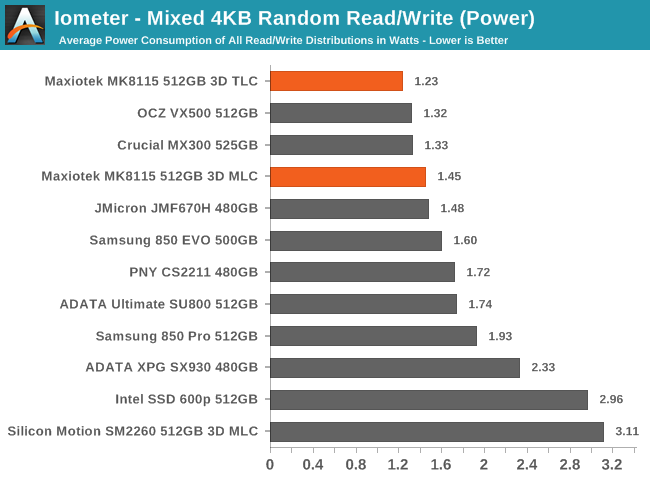
The MK8115 with TLC ends up using less power to deliver almost exactly the same performance, so the TLC drive scores a minor win for efficiency. They're both still beat by a wide range of mainstream SSDs.
 |
|||||||||
Both MK8115 drives show a normal spike in performance at the end of the test when the workload shifts to pure writes. During the rest of the test, performance is mostly constant instead of the more usual pattern of growing steadily with the proportion of writes in the workload. The TLC drive is substantially faster than the MLC drive in the initial all-reads phase of the test, but it is slightly slower through the middle of the test and that gives it the slower overall average.
Mixed Sequential Read/Write Performance
The mixed sequential access test covers the entire span of the drive and uses a queue depth of one. It starts with a pure read test and gradually increases the proportion of writes, finishing with pure writes. Each subtest lasts for 3 minutes, for a total test duration of 18 minutes. The drive is filled before the test starts.
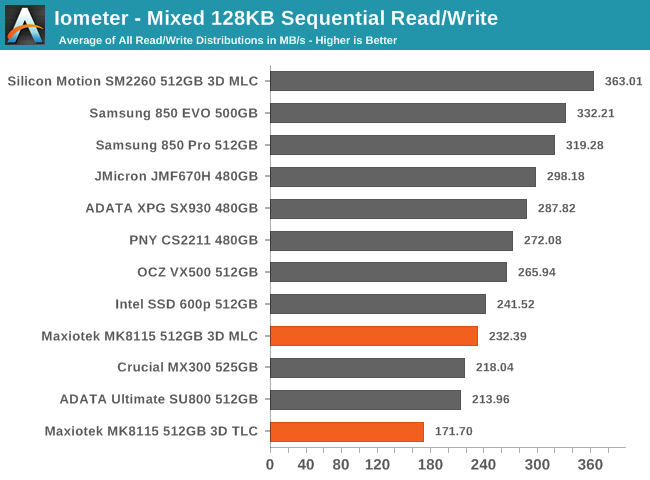
The MK8115 drive with MLC has much higher average performance on the mixed sequential workload test than its TLC counterpart, which is quite clearly the slowest drive. The MLC manages to outperform two TLC drives, but doesn't come close to matching the next slowest MLC drive on this test.
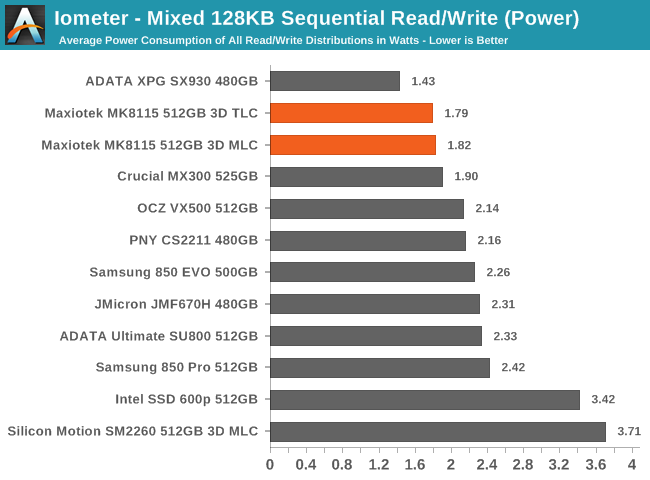
Both MK8115 drives draw about the same amount of power during the mixed sequential workload test. The MLC drive requires slightly more power but is substantially more efficient due to its higher performance, and it actually beats the Crucial MX300 for efficiency here.
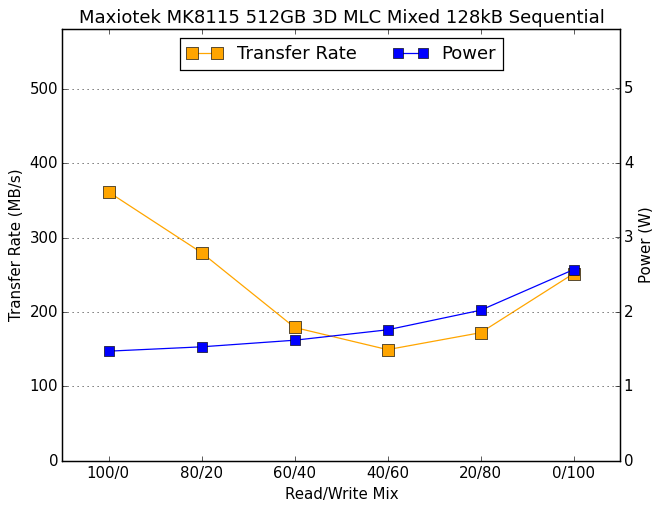 |
|||||||||
The MLC drive's performance curve across the mixed sequential test is the U shape that is normal for mainstream SSDs, though the minimum performance of around 150MB/s is a bit on the low side. The TLC drive by contrast slows down steadily as more writes are added, and doesn't recover any performance near the end of the test.










60 Comments
View All Comments
CheapSushi - Wednesday, May 10, 2017 - link
So you sold someone something without researching the hardware in it yourself? Kinda shady but likely he still enjoyed it.rocky12345 - Wednesday, May 10, 2017 - link
Shady? It was a pre built with 3 year warranty the finer detailed spec's were not revealed as in brands like SSD or system memory. He also wanted a gaming system but did not want to pay a lot of money. I would normally build the system myself as a custom so you know what every part is inside and you get to choose the build quality but since he wanted a gaming system on the cheap he got a pre built system. He is happy with it and it actually is a nice system for the money and he got a 3 year warranty from the OEM. So nothing shady going on here...lolwatzupken - Tuesday, May 9, 2017 - link
I am not sure if the price of such DRAM less SSDs is worth buying over a normal budget SSD. In every instance, it is performing very poorly against a budget SSD with DRAM.Lolimaster - Sunday, May 14, 2017 - link
If you're not an OEM than will sells tons of system to uninformed customers, get a good TLC or MLC if possible.jabber - Tuesday, May 9, 2017 - link
Bring back the good old BX100!nervegrind3r - Tuesday, May 9, 2017 - link
inZGamer - Saturday, May 13, 2017 - link
As much as people complain about the low performance....when benchmarking the drive, why compare it against high end consumer SSD's? Compare it against HHD's and SSHDs's where it would actually make sense. This style of drive is not intended to compete against an EVO 850, maybe an MX300 but that would even be pushing it. It will be interesting to see where this is kind of budget SSD ends up on the $/GB scale when it actual reaches production.Lolimaster - Sunday, May 14, 2017 - link
People are actually getting scammed with the prebuild OEM systems with SSD because THAT's when they will include shi*tty dram-less SSD's (in bulk $5-10 off of each system to sell them at the same price is a lot for OEM's).Similar to TLC SSD's, dram-less SSD's consistency goes to sh*t when you empty the SLC cache, if you don't implement it, even worse, you basically get writes slower than a 5400rpm HDD with the system pegging.
I would only touch 850 EVO's, Crucial MX300 for TLC, Kingston HyperX Savage or 850 pro for MLC.
genzai - Tuesday, May 16, 2017 - link
Seems like one good use for Optane would be to replace the DRAM (over a DDR interface) on drives like these.